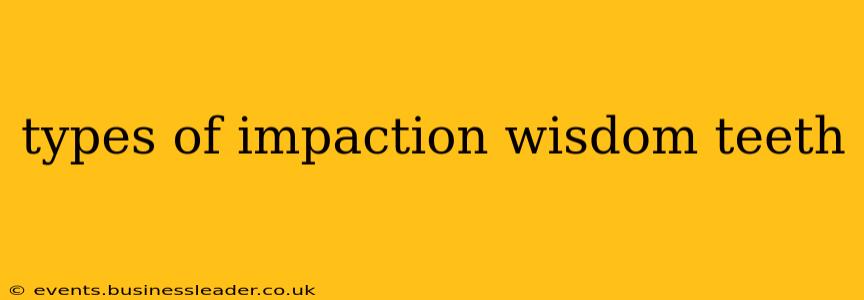Wisdom teeth, also known as third molars, are the last teeth to erupt in the mouth, typically appearing between the ages of 17 and 25. However, many people never experience the eruption of their wisdom teeth at all. This is because they are impacted—meaning they are trapped beneath the gum line or bone, unable to fully erupt. Understanding the different types of impaction is crucial for proper diagnosis and treatment planning.
What are Impacted Wisdom Teeth?
Before diving into the specific types, it's important to understand what constitutes an impacted wisdom tooth. An impacted tooth is one that is unable to break through the gum line due to several factors, including lack of space in the jaw, the angle of the tooth, or surrounding bone density. This can lead to pain, infection, and other dental problems. Early diagnosis and proper management are key to preventing these issues.
Types of Wisdom Tooth Impaction
Impacted wisdom teeth are categorized based on their position relative to the second molar and the surrounding bone and gum tissue. The most common classification system uses the following categories:
1. Partial Impaction
In a partial impaction, the wisdom tooth partially erupts through the gum line. A portion of the tooth is visible, while the rest remains covered by gum tissue. This type of impaction can be particularly problematic because the partially erupted tooth is more susceptible to food particles becoming trapped, leading to inflammation, decay, and potential infection. Cleaning this area thoroughly can be challenging.
2. Complete Impaction
A completely impacted wisdom tooth is entirely covered by gum tissue and bone. It is completely submerged and not visible in the mouth. This type of impaction often doesn't cause immediate symptoms unless infection or other complications arise. However, it still requires monitoring and may ultimately necessitate extraction.
3. Soft Tissue Impaction
In a soft tissue impaction, the wisdom tooth is covered only by gum tissue and is not embedded in the bone. This is a relatively less severe form of impaction compared to bony impactions.
4. Bony Impaction
A bony impaction means that the wisdom tooth is completely embedded in the jawbone. This type often presents more challenges for extraction as the surgeon needs to remove bone to access the tooth. This type of impaction may also require more advanced surgical techniques.
5. Mesioangular Impaction
This is a common type of impaction where the wisdom tooth is angled towards the front of the mouth, leaning against the second molar. The angle of the impaction can significantly impact the difficulty of extraction.
6. Distoangular Impaction
Here, the wisdom tooth leans towards the back of the mouth, away from the second molar. While less common than mesioangular impaction, distoangular impaction can still cause complications.
7. Horizontal Impaction
In a horizontal impaction, the wisdom tooth lies completely horizontally within the jawbone. This is a significant form of impaction and often requires a more complex extraction procedure.
How are Impacted Wisdom Teeth Diagnosed?
Diagnosis usually involves a thorough oral examination and panoramic X-rays. Panoramic X-rays provide a comprehensive view of the entire jaw, allowing the dentist or oral surgeon to assess the position, orientation, and relationship of the wisdom teeth to surrounding structures.
What are the Symptoms of Impacted Wisdom Teeth?
Symptoms vary depending on the type and severity of impaction. Some individuals may experience no symptoms at all, while others may encounter pain, swelling, infection (pericoronitis), gum disease, or damage to adjacent teeth.
When Should I See a Dentist About My Wisdom Teeth?
Regular dental checkups are essential. Early detection of impaction can prevent more serious complications later on. If you experience any pain, swelling, or other issues related to your wisdom teeth, seek dental attention promptly.
Disclaimer: This information is intended for educational purposes only and should not be considered medical advice. Always consult with a qualified dentist or oral surgeon for diagnosis and treatment of impacted wisdom teeth.
